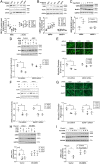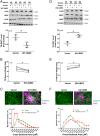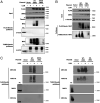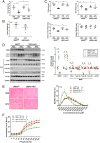UBR2 targets myosin heavy chain IIb and IIx for degradation: Molecular mechanism essential for cancer-induced muscle wasting
- PMID: 36252004
- PMCID: PMC9618047
- DOI: 10.1073/pnas.2200215119
UBR2 targets myosin heavy chain IIb and IIx for degradation: Molecular mechanism essential for cancer-induced muscle wasting
Abstract
Cancer cachexia is a lethal metabolic syndrome featuring muscle wasting with preferential loss of fast-twitching muscle mass through an undefined mechanism. Here, we show that cancer induces muscle wasting by selectively degrading myosin heavy chain (MHC) subtypes IIb and IIx through E3 ligase UBR2-mediated ubiquitylation. Induction of MHC loss and atrophy in C2C12 myotubes and mouse tibialis anterior (TA) by murine cancer cells required UBR2 up-regulation by cancer. Genetic gain or loss of UBR2 function inversely altered MHC level and muscle mass in TA of tumor-free mice. UBR2 selectively interacted with and ubiquitylated MHC-IIb and MHC-IIx through its substrate recognition and catalytic domain, respectively, in C2C12 myotubes. Elevation of UBR2 in muscle of tumor-bearing or free mice caused loss of MHC-IIb and MHC-IIx but not MHC-I and MHC-IIa or other myofibrillar proteins, including α-actin, troponin, tropomyosin, and tropomodulin. Muscle-specific knockout of UBR2 spared KPC tumor-bearing mice from losing MHC-IIb and MHC-IIx, fast-twitching muscle mass, cross-sectional area, and contractile force. The rectus abdominis (RA) muscle of patients with cachexia-prone cancers displayed a selective reduction of MHC-IIx in correlation with higher UBR2 levels. These data suggest that UBR2 is a regulator of MHC-IIb/IIx essential for cancer-induced muscle wasting, and that therapeutic interventions can be designed by blocking UBR2 up-regulation by cancer.
Keywords: MHC-IIb; MHC-IIx; UBR2; cancer cachexia; ubiquitylation.
Conflict of interest statement
The authors declare no competing interest.
Figures







Similar articles
-
Upregulation of E3 ligase UBR2 in acetaldehyde-treated C2C12 myotubes and its potential involvement in fast-twitch muscle atrophy in alcohol-fed rats.Alcohol Clin Exp Res (Hoboken). 2025 Aug;49(8):1667-1677. doi: 10.1111/acer.70102. Epub 2025 Jun 13. Alcohol Clin Exp Res (Hoboken). 2025. PMID: 40511880
-
Effect of heart failure on skeletal muscle myofibrillar protein content, isoform expression and calcium sensitivity.Int J Cardiol. 2006 Feb 15;107(2):211-9. doi: 10.1016/j.ijcard.2005.03.024. Int J Cardiol. 2006. PMID: 16412799
-
The continuum of hybrid IIX/IIB fibers in normal mouse muscles: MHC isoform proportions and spatial distribution within single fibers.Am J Physiol Regul Integr Comp Physiol. 2010 Dec;299(6):R1582-91. doi: 10.1152/ajpregu.00402.2010. Epub 2010 Sep 22. Am J Physiol Regul Integr Comp Physiol. 2010. PMID: 20861278 Free PMC article.
-
Evidence for three fast myosin heavy chain isoforms in type II skeletal muscle fibers in the adult llama (Lama glama).J Histochem Cytochem. 2001 Aug;49(8):1033-44. doi: 10.1177/002215540104900811. J Histochem Cytochem. 2001. PMID: 11457931
-
Fiber-Type Shifting in Sarcopenia of Old Age: Proteomic Profiling of the Contractile Apparatus of Skeletal Muscles.Int J Mol Sci. 2023 Jan 26;24(3):2415. doi: 10.3390/ijms24032415. Int J Mol Sci. 2023. PMID: 36768735 Free PMC article. Review.
Cited by
-
Revealing the Mechanism of Protein Degradation in Postmortem Meat: The Role of Phosphorylation and Ubiquitination.Foods. 2025 Jan 9;14(2):184. doi: 10.3390/foods14020184. Foods. 2025. PMID: 39856851 Free PMC article.
-
The role of UBR2 in triple-negative breast cancer and its implications for immune checkpoint blockade therapy.Discov Oncol. 2025 Jul 17;16(1):1357. doi: 10.1007/s12672-025-03153-3. Discov Oncol. 2025. PMID: 40676335 Free PMC article.
-
Emerging role of TAK1 in the regulation of skeletal muscle mass.Bioessays. 2023 Apr;45(4):e2300003. doi: 10.1002/bies.202300003. Epub 2023 Feb 15. Bioessays. 2023. PMID: 36789559 Free PMC article. Review.
-
IFNα/JAK/STAT1 Axis-Induced FBXO4 Modulates Muscle Cell Differentiation via β-Catenin Degradation in Dermatomyositis.J Inflamm Res. 2025 Jun 27;18:8527-8539. doi: 10.2147/JIR.S506056. eCollection 2025. J Inflamm Res. 2025. PMID: 40599691 Free PMC article.
-
Exploring heterogeneity: a dive into preclinical models of cancer cachexia.Am J Physiol Cell Physiol. 2024 Aug 1;327(2):C310-C328. doi: 10.1152/ajpcell.00317.2024. Epub 2024 Jun 10. Am J Physiol Cell Physiol. 2024. PMID: 38853648 Free PMC article. Review.
References
-
- Sadeghi M., et al. , Cancer cachexia: Diagnosis, assessment, and treatment. Crit. Rev. Oncol. Hematol. 127, 91–104 (2018). - PubMed
-
- Fearon K., et al. , Definition and classification of cancer cachexia: An international consensus. Lancet Oncol. 12, 489–495 (2011). - PubMed
-
- Acharyya S., et al. , Dystrophin glycoprotein complex dysfunction: A regulatory link between muscular dystrophy and cancer cachexia. Cancer Cell 8, 421–432 (2005). - PubMed
-
- Li Y. P., Schwartz R. J., Waddell I. D., Holloway B. R., Reid M. B., Skeletal muscle myocytes undergo protein loss and reactive oxygen-mediated NF-kappaB activation in response to tumor necrosis factor alpha. FASEB J. 12, 871–880 (1998). - PubMed
Publication types
MeSH terms
Substances
Grants and funding
LinkOut - more resources
Full Text Sources
Medical
Molecular Biology Databases
Research Materials

